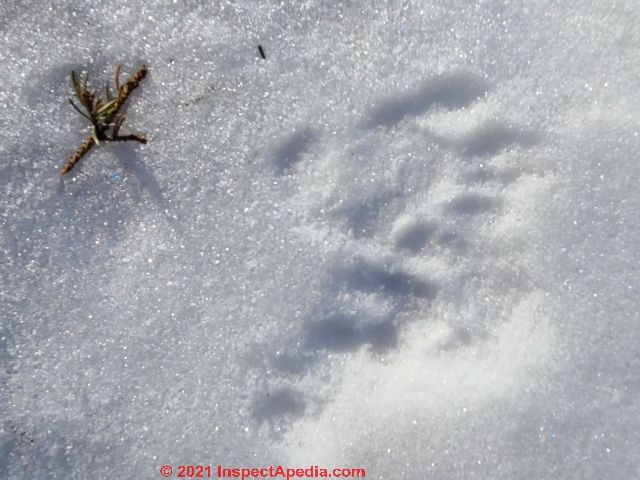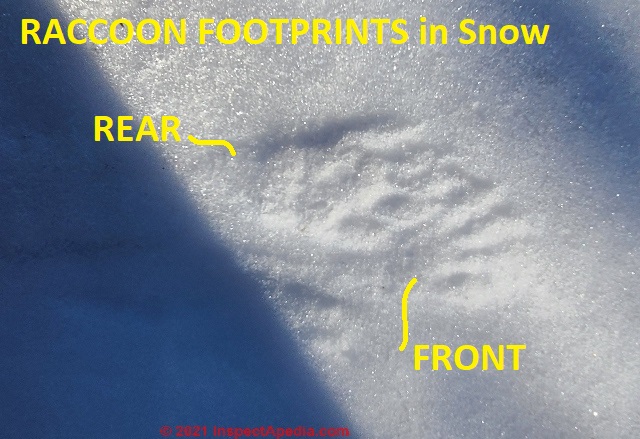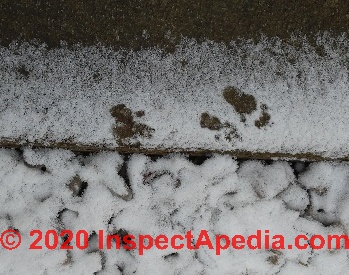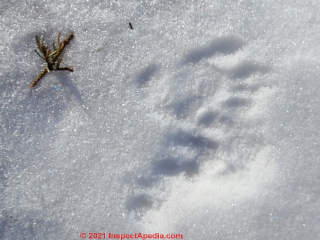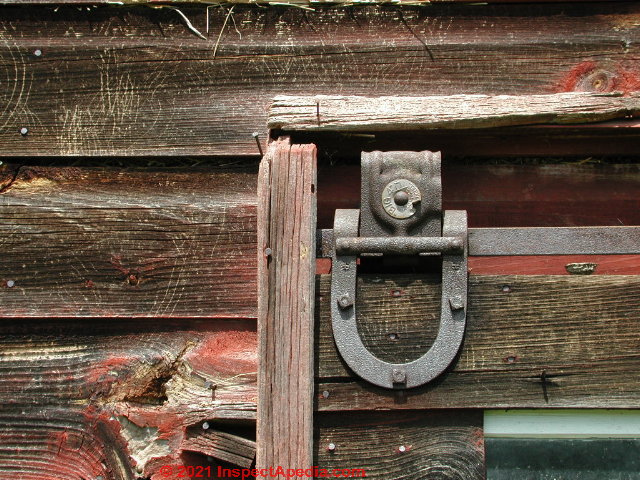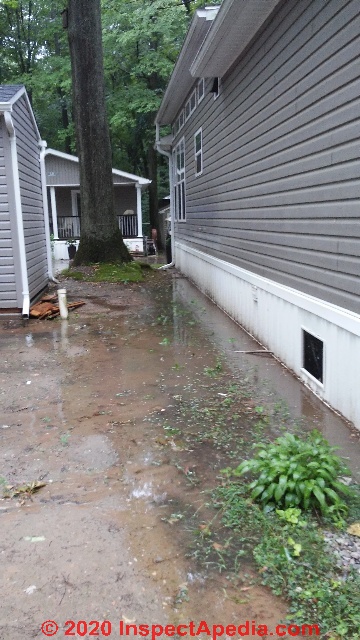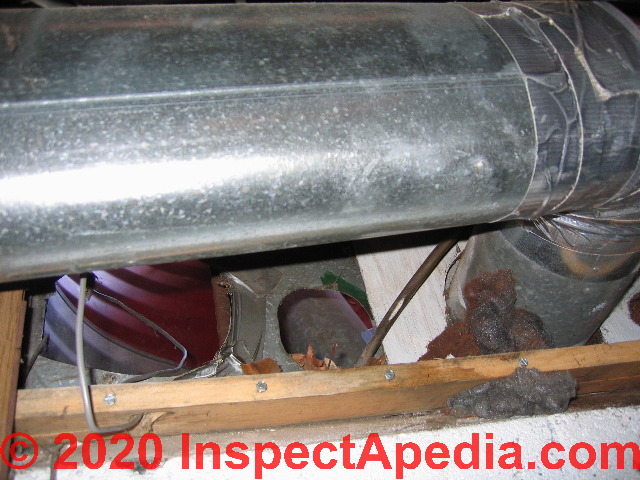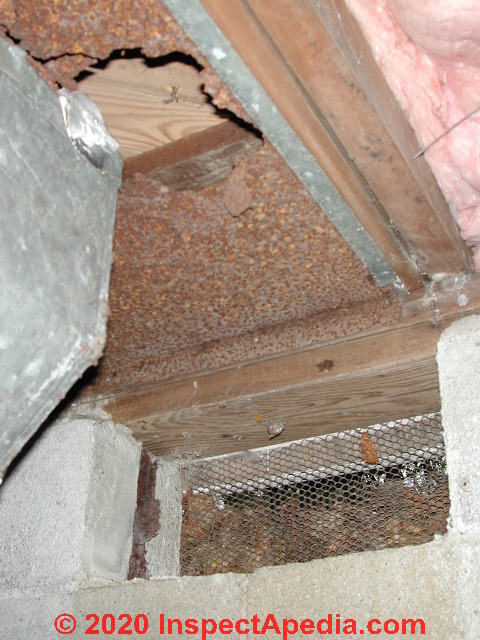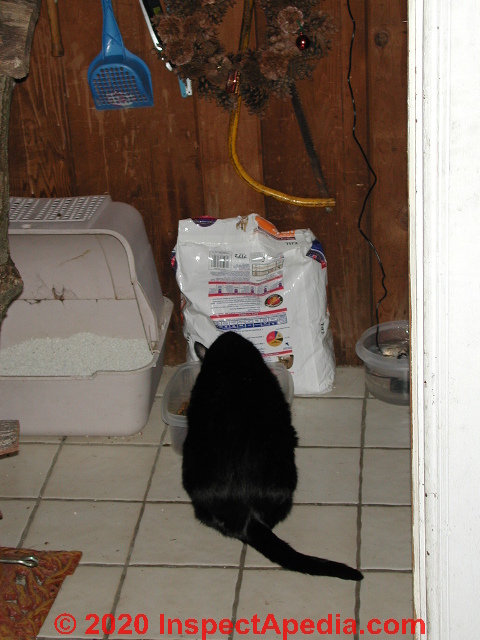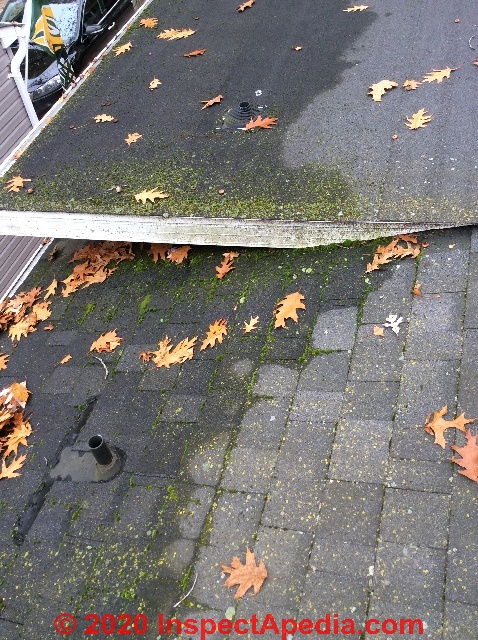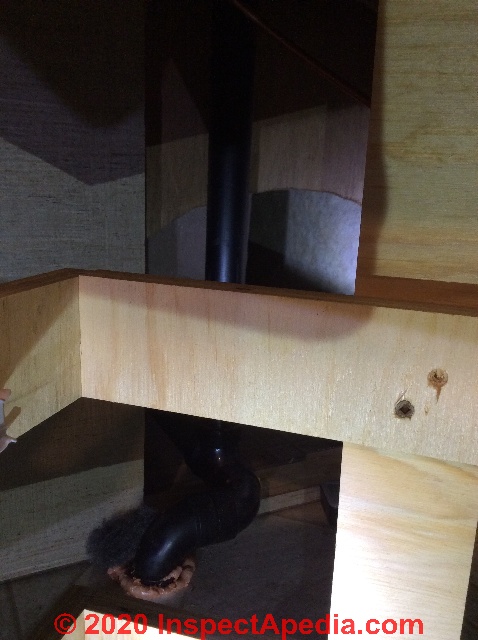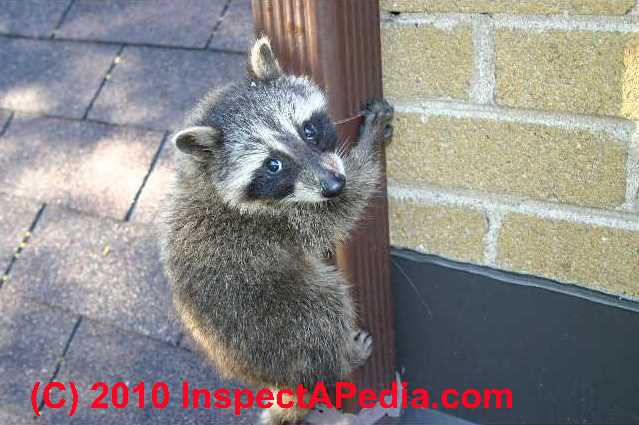 Keeping Raccoons out of your Building
Keeping Raccoons out of your Building
Raccoons (Procyon lotor) invade an attic at Christmas
- POST a QUESTION or COMMENT about how to keep animal pests out of buildings
Raccoons indoors: entry points, behavior, repellents in buildings, health risks.
This article combines a true story with advice about dealing with raccoon invasions of buildings. We describe the raccoon's noisy appearance in a home's attic during the Christmas holidays and how the occupants responded.
This article series explains how to find where animals are getting into your building and how to keep them out, including bats, birds, rats, mice, and squirrels and even raccoons.
InspectAPedia tolerates no conflicts of interest. We have no relationship with advertisers, products, or services discussed at this website.
- Daniel Friedman, Publisher/Editor/Author - See WHO ARE WE?
Raccoons Invading Buildings
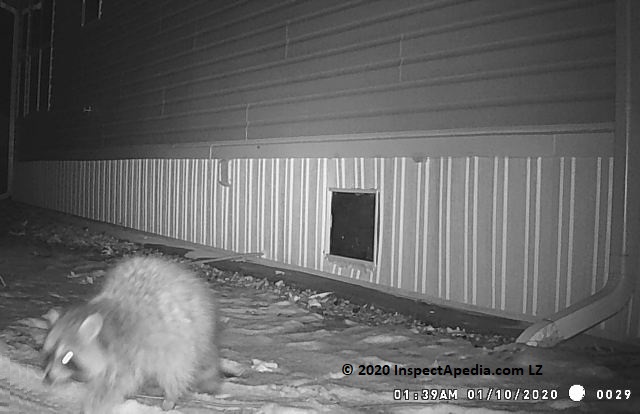 Here, following a true story about a raccoon invasion of a New York home's attic, we describe health warnings about wild raccoons in a building.
Here, following a true story about a raccoon invasion of a New York home's attic, we describe health warnings about wild raccoons in a building.
For people who want to identify their wild animal invader, we include details of raccoon footprints and compare them with other small animals.
Night photo of a raccoon shown here was captured by a Canadian reader who finally caught their invader on a wildlife camera triggered by movement.
The raccoon had been invading the home's crawl space and other areas - discussed in detail at HOW to IDENTIFY an ANIMAL INVADER.
Article Contents
- RACCOONS in the ATTIC - a Christmas Story - we heard a "smack, rattle rattle roll" noise in our attic. What the heck?
- RACCOON EXPOSURE HEALTH WARNINGS - rabies?
- OTHER WILD ANIMAL HEALTH HAZARDS & ISSUES - it's not just rabies
- RACCOON TRACK IDENTIFICATION - whose are those little footprints in the snow?
- RACCOON TRACKS vs SQUIRRELS & PORCUPINES - each has distinctive properties
- HOW to IDENTIFY an ANIMAL INVADER - wildlife camera?
- RESEARCH: RACCOON BEHAVIOUR & HAZARDS
If you are only interested in finding and closing the points where animal(s) are getting into your building, go directly
to ANIMAL ENTRY POINTS in BUILDINGS - home
"Wild" Animals Live Successfully in Urban Areas
Raccoons are a common sight in large cities; we've even seen them tearing off garbage can lids in downtown Chicago, especially in cold weather.
The history of carnivores and humans in North America has not been one of amicability or tolerance. ... To some extent this continues today within many urban landscapes ...
I will characterize the relationships between people and medium-sized carnivores that seem to be highly successful in urban systems: raccoons (procyon lotor), striped skunks (Mephitis mephitis, and coyotes (Canis latrans). - Gehrt, in People and Predators: From Conflict to Coexistence (2004).
Tibbs (2007) and Ridenour (2011) both point out that raccoons actually prefer the indoors of buildings when selecting a winter den, while Bozek (2007) added that raccoons are not above finding habitat in sewers and storm drains.
...
Raccoons in the Attic: A Christmas Story
The following raccoon story illustrating Gehrt's point that raccoons are not a bit afraid of us is true, only Laura Waterman's name has not been mentioned.
Dan and Laura were snuggled up reading in bed on a cold Poughkeepsie January night. Suddenly overhead they heard
SMACK! rattle, rattle, rattle, rattle, rattle, rattle, roll. Something or someone was in the attic! Now they heard the sound of little clawed feet scampering across the attic floor just over their heads.
The home, 57 S. Grand Avenue, Poughkeepsie, built in 1900, was a neo-Victorian with a large walk-up attic wherein were stored the usual detritus, old rugs, suitcases, trunks, broken lamps, bicycle parts, and other who-knows-what. Some animal, maybe more than one of them, was smashing something around in the attic. What the hey?
Dan tiptoes over to the door at the bottom of the attic stairs in his pajamas. He leans an ear against the cold red-varnished wood. Cold air leaks out of the attic and rolls across his bare toes adding to the chill of the sounds of intruders above.
SMACK! rattle, rattle, rattle, rattle, rattle, rattle, roll. More scurrying about, excitedly running to and fro across the wooden attic floor.
Trained in several forms of combat and three martial arts, Laura nevertheless cowers in their bedroom doorway.
"Don't open that door!" she advises in a voice quavering with emotion. "I'm telling you, for god's sake, don't open that door!"
Dan remembers having recently freed a real estate agent who'd been shut tight into the attic of another New York home by Dennis the Menace, the first and last child of her clients. Dennis slammed the attic door shut and ran downstairs, hopped into the family car, and Dad drove them away.
The agent was later heard shouting out of a third floor window. "Soooomebody, Get me outa here!" It took some hammering, prying, and some gouging scarring of the door to get her out.
Dan grimaces in thought. He is glad that their attic door, too, can be difficult to open.
SMACK! rattle, rattle, rattle, rattle, rattle, rattle, roll. More scurrying. SMACK! rattle, rattle, rattle, rattle, rattle, roll. SMACK! rattle roll, roll, roll, smack rattle, roll.
Dan leans harder on the door to be sure it is latched tightly and inspects the lock.
"We'll check up there tomorrow when whatever it is has gone out for water" he concludes.
SMACK! rattle, rattle, roll, rattle, SMACK! rattle, rattle, rattle, roll, roll, roll. More scurrying, this time they hear nasty little feet scampering about, maliciously tearing paper, and gleefully rolling things about on the floor. Only the sounds of human giggling and laughter were missing.
By dawn the smacking, rattling, rolling and scampering had subsided. The intruders were asleep.
Or they had gone out for breakfast at the convenient and always-open Poughkeepsie Diner dumpster. Dan knows about the dumpster because his dog Katie made a beeline for it whenever she ran away.
Laura waited. Dan waited. Mara was still sleeping in her own bedroom - they'd shut her door, too.
After the humans had eaten their own breakfast (from the refrigerator not the dumpster), they took a walk around the house outside. Close inspection showed an open board on the under-side of the left rear roof soffit, lots of soot smudges, and a short leap-distance away, the huge old oak tree near the corner of the house.
They waited some more. Listening against the attic door: silence. Nobody really wanted to open the door but finally, carefully Dan and Laura ease open the door.
Then, thinking some more, they close the door and go back to the kitchen where they gather their biggest pots and pans.
Throwing open the attic door and shouting "BEAT IT YOU BUMS" they bang the pots and pans together. BANG! CLANK!
The pans become lopsided, the pan handles bend and two pots are ruined. So is their hearing. Some neighbours are on the verge of calling the sheriff but they don't.
But the attic is empty of intruders. Most likely the attic was already empty before Laura and Dan even started all that bang-clank foolishness.
Next they tiptoe up the attic stairs to see an amazing sight: there are sooty raccoon footprints everywhere. Everywhere! The attic has been ransacked.
Scattered about the floor are two dozen bright, shiny green, red and gold Christmas ornaments that the raccoons have found irresistible. Ornaments are everywhere. A Christmas miracle, not one ornament has been broken. They're dirty, though.
How could this be?
The Christmas ornaments had been stored in a cardboard box that was itself at the bottom of a pile of other stored items. The raccoons had found the box, opened it, taken out the ornaments, and initiated a smack, rattle and rolling ornament festival on the attic floor.
Laura begins picking up the fragile blown glass bulbs, pyramids, Santa-Houses, stars, and whatnots. Together they replace the ornaments back into the compartmented box.
Thinking about the raccoons and that the soffit is still open to intruders, Dan opens a large chest, lifts out its contents (old wedding dress, towels with frayed edges and holes, bathing suits worn by his parents in 1939, shoes and a faded Confederate flag from Richmond).
He places these aside. The box of ornaments is placed in the bottom of the chest and the chest is then re-filled with the rest of its contents. The heavy cover is closed. There's no lock.
After some sweeping up, they close the attic door and put a couple of bricks against it from outside.
"Tomorrow we'll borrow Art's 40-foot ladder and nail up that soffit", Dan offers. Laura smiles and looks doubtful. It's still cold outside. Mara, home from school passes the attic door and asks "Hey Dad, why are all those bricks leaning against the door"?
After a quiet dinner they read, then retire to read some more. (Any other possible activities that they might have pursued will not be discussed in this raccoon field report). Reading. Reading.
There is no TV. They don't have a TV, but Mara's teachers don't believe that and accuse her of being sassy.
SMACK! rattle, rattle,rattle, rattle, rattle, roll !! Scurry, scurry, scurrying feet. SMACK! rattle, rattle, roll. SMACK! SMACK! SMACK! rattle, rattle, rattle, rattle, rattle, roll. More scurrying.
"You have to be kidding me!" Dan exclaims. He and Laura run barefoot out the back door to the barn. From there they carry all of the spare bricks from the barn back upstairs and pile them against the attic door. It takes four trips. Then they wait for morning.
The second morning they again enter the attic. More sooty footprints. The raccoons had not a moment's trouble sniffing out the box of ornaments where it had been hidden. They must have teamed up - surely it would have have taken at least two of them, maybe four, to open that old storage chest.
Once opened by PROST, the Poughkeepsie Raccoon Ornament Smacking Team, the chest quickly yielded up its old wedding dress, towels with frayed edges and holes, bathing suits worn by his parents in 1939, shoes and the Confederate flag from Richmond - these have been tossed aside and the box of ornaments has again been taken out, opened, and its contents served up to all four corners of the attic.
Again not one ornament has been broken. But this time one of the raccoons from Poughkeepsie has peed on the Confederate flag from Richmond.
The humans now understand. This event is going to continue until the raccoons get tired of it or until Dan nails new plywood onto the soffit.
Jewish people ought not to store Christmas decorations. What are they doing with them anyway?
...
Health Warnings When Handling Dead Raccoons or Cleaning Up Raccoon Mess: Rabies?
Watch out: some raccoons may carry rabies or other disease.
Our photograph shows the authors [DF/JC] transporting an obviously very sick raccoon away from a home's back entry door.
The raccoon was so sick it could barely walk. It crawled into the 5-gallon plastic bucket in our photo.
When we lifted the bucket using a garden rake, the raccoon barely moved. Had it been more active we'd all have run away to call the county animal control officer or health department.
Avoid trapping a raccoon indoors where people are also present and don't try to handle or catch one unless you're a trained, equipped professional.
Avoid raccoons that you see stumbling about in the day time.
Raccoons that were found during the day or that exhibited abnormal behavior and those that had interacted with a domestic animal were more likely to be rabid. - Jenkins (1988)
Watch out: when cleaning up raccoon poop you should use only HEPA-rated vacuum equipment, and protective gear may be in order.
Besides the popularly-discussed rabies hazard (Jenkins 1988), Kazacos (1985) and others we cite just below point out that there are some rare but serious human illnesses that may be spread by raccoons.
...
How to Recognize Raccoon Tracks
Above and below: photographs of raccoon tracks in the snow along the edge of Lake Superior, Two Harbors MN in January, 2021
Often a raccoon's track shows footprints close together (right and left) or even stepping onto the same smaller area - as shown in our first photo above: raccoons know a good Tango step. They have claws but the claws are small and sharp and either don't show up at all in footprints (in snow) or in mud they might show up as a tiny dot in front of each toe.
Our raccoons in the attic left sooty footprints all over the place, but more often you'll see raccoon footprints in soft soil, a muddy river bank, or in snow - as we illustrate below.
Note: Even if you don't see the raccoon itself you might recognize their footprints.
Raccoon footprints are elongated with distinctive long "toes" and are typically
- Raccoon front feet: 2-3 inches in length with a more-rounded or C-shaped footprint (some sources cite 1 - 3") and the base of the track may appear as an open "C" with the opening of the C pointing rearwards.
- Raccoon back feet: 3-4 inches in length with an elongated heel pad in the raccoon footprint (some sources cite 1.5 - 4" depending on the raccoon's age).
You'll also notice an elongated "thumb" on each raccoon front "hand" or rear foot.
The raccoon's rear feet (shown in my photo) are noticeably longer than their front feet.
How do we know it's not an opossum track in the photos above? Possom tracks are much much sorter and are smaller.
...
How to Look at Small Animal Tracks: Squirrel vs Raccoon
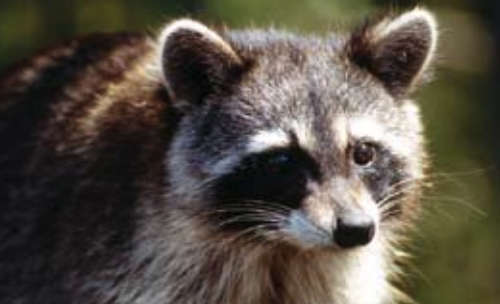 Raccoon Procyon lotor track size and shape vs Squirrels & Porcupines
Raccoon Procyon lotor track size and shape vs Squirrels & Porcupines
Photo: an adult raccoon, courtesy of U.S. CDC.
A raccoon track is bigger, 2-3 inches across and unlike squirrels, raccoons have 5 finger-like "toes" on both their front and hind feet.
Their claws are usually distinct in the footprint.
Raccoon tracks also show a longer hind foot and a shorter front foot that looks a lot like a handprint.
Raccoon front tracks are between 1 9/16" and 3 1/8" long and between 1 9/16" and 2 7/8" wide and have five toes.
Raccoon rear tracks are typically between 1 15/16" and 4" long and between 1 7/16" and 2 15/15" wide, with 5 toes.
Of course young raccoons will have similar footprints but be smaller in size.
Also raccoons walk differently from squirrels. They amble along such that in pairs of tracks you will usually see a hind foot adjacent to a front foot in pairs.
Porcupines also occasionally show up around homes but I doubt you've got those right around such a built-up area in London Ontario.
- Special thanks to Beartracker's Animal Tracks Den, Kim. A. Cabrera, at bear-tracker.com for help with sizing animal footprints. https://www.bear-tracker.com/gsquirel.html and https://www.bear-tracker.com/coon.html retrieved 2020/01/10
- Wikipedia, Black Squirrel, retrieved 2010/01/10 original source: https://en.wikipedia.org/wiki/Black_squirrel
The photo above of small animal footprints, is provided courtesy of reader LZ who asked if those were from a raccoon.
We said: Those footprints could be from a squirrel or a raccoon; if you take another photo with a ruler laid along the track we can be more confident.
Below: Raccoon tracks in the snow, Two Harbors Minnesota, winter 2021.
Squirrel track size and shape
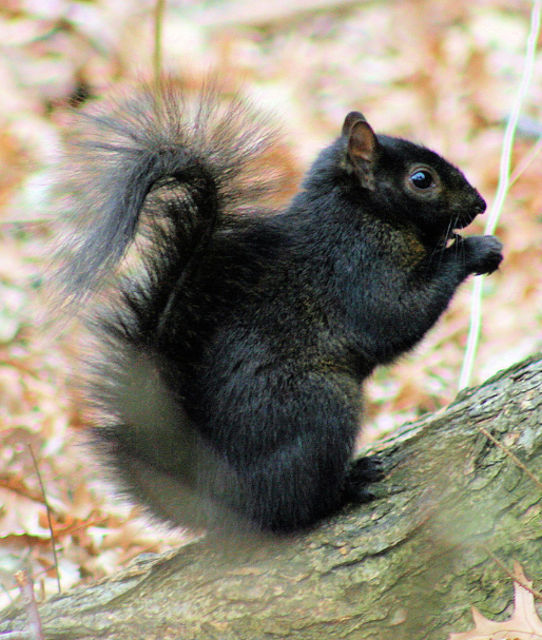 Squirrel tracks, using the Gray Squirrel (Scirus griseus) as an example are usually less than two-inches wide or long.
Squirrel tracks, using the Gray Squirrel (Scirus griseus) as an example are usually less than two-inches wide or long.
Squirrel front tracks are between 1 1/4" and 1 7/8" long and between 3/4" and 1 3/4" wide and sport four toes.
Squirrel hind foot tracks are between 1 1/4" and 2 1/16" long and between 1 and 1 3/4" wide and have five toes.
The shape of squirrel tracks have a longer hind foot than front foot.
Squirrel tracks appear with like feet most-often in pairs as they hop rather than walk. (In comparison, see my raccoon track notes below.)
Also I'd like a closer view to see if there are distinct claw marks.
In Canada we have several types of squirrels including the Eastern Gray Squirrel (Sciurus carolinensis), black squirrels (a subgroup of the eastern gray and fox squirrels), red squirrel and fox squirrels
Photo above: a Canadian black squirrel such as may be seen in Ontario. When these animals show up wearing a reddish-brown coat they're identified as fox squirrels.
I think those track pairs in your photo are of a combined hind foot and front foot (arguing for a raccoon) but I need to know their size.
In the photo below, by their size and location, these are probably raccoon scratches on the exterior siding of a barn (D Friedman 2001, Catskills NY) .
Squirrels and mice also gnaw and scratch at buildings and building components but the scale of those marks is usually notably smaller.
...
Other Health Hazards from Animals
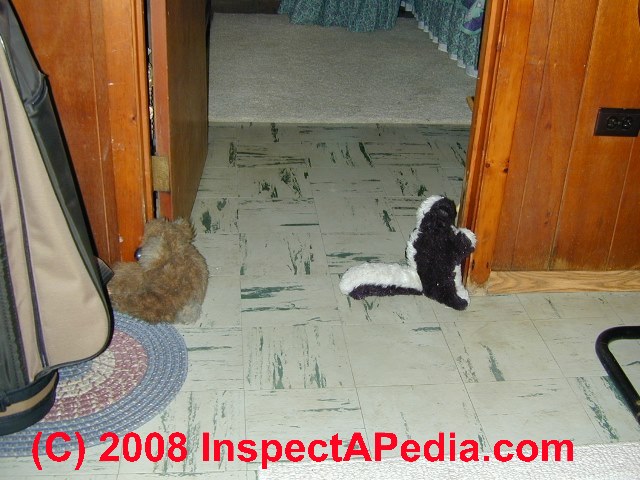 The little stuffed animals in this photo include a skunk - both were innocent of any pet-crimes, but they had been placed at either side of a basement door jamb to cover stains from basement water entry.
The little stuffed animals in this photo include a skunk - both were innocent of any pet-crimes, but they had been placed at either side of a basement door jamb to cover stains from basement water entry.
But real wild animals, including raccoons and skunks can be a source of serious health risks.
Watch out: in addition to their common role as allergens, animal feces, urine, even hair can offer serious health hazards including from various pathogens: bacteria, viruses, even possibly rabies.
Watch out: also for wild animal bites, bacterial and viral hazards when entering confined spaces where invaders are or have been present.
The author (DF) became temporarily ill after (foolishly) working in a "clean looking" crawl space that later he realized had a heavy contamination of fecal and urine contaminated mouse dust.
Bat and rodent droppings as well as bird droppings can be a source of a pathogen potentially dangerous to humans, the fungus Histoplasma capsulatum.
Watch out: before sealing up a hole in a soffit or wall where squirrels or bats are entering your building, make sure the animals are not going to be trapped inside where they will be mad, frightened, hostile, even dangerous (like a rabid raccoon), or ultimately dead and another source of stink.
- If the raccoons peed and pooped in your home you should also
see ANIMAL or URINE ODOR SOURCE DETECTION
followed by ANIMAL or URINE ODOR REMOVAL. - If your building odor complaint source is found to be outdoors, it's probably not the raccoons' fault, but more likely dogs, occasionally cats and sometimes people.
See URINE ODOR REMOVAL at BUILDING EXTERIOR.
...
How to Identify an Animal Invader in your Building
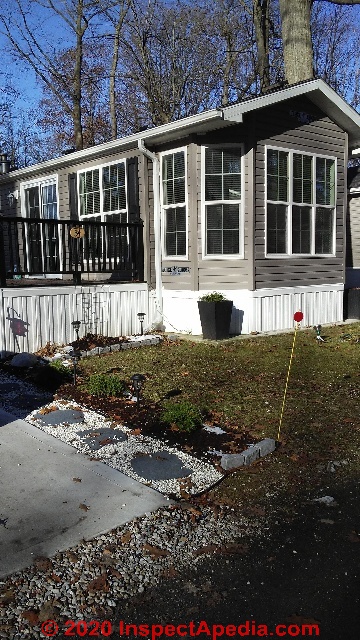 Reader Question: trouble getting rid of animal invaders in my Ontario manufactured home: Baby Raccoons?
Reader Question: trouble getting rid of animal invaders in my Ontario manufactured home: Baby Raccoons?
Hello, I have just come across your webpage and really feel like maybe I can move forward with the problem I am having.
I live just outside of London, Ontario in an adult manufactured home community. My home was built by General Coach in Hensal, Ontario.
The home is 8 years old and I am have a problem with wildlife getting in between the subfloor and belly liner. I am pretty certain I have squirrels, and either raccoons or opossum.
I have seen squirrels going up the tree beside my home and raccoons having been spotted outside walking around close to the outside walls of the house.
I have had 5 different professional wildlife companies out to inspect the house as well General Coach has had someone come and try to solve the problem and I have spent a great deal of time and money trapping, checking for tracks, (not much snow so tracks are not offering conclusive direction), sealing up vulnerable spaces and having friends and family try to help me solve this problem.
The last professional company to come and look used a thermal camera on a cell phone and located a critter exactly where I knew it would be as I have been living with this problem for a few months now and have noticed noise and smell patterns in the house.
Anyway because the house sits on a concrete pad with approximately 2 feet of crawl space headroom the wildlife people will not attempt to forcibly remove the animal.
They would prefer to put an exclusion door on the house and then fix the access or accesses.
Problem is no one can see where the critters are getting in squirrels or larger wildlife. The professionals keep saying I would see big damage and so even when I ask about thermal imaging to detect hidden hole they won’t scan the house.
Presently I have a trail cam set up and am moving it to various locations to see if I can find the access but have not been successful to date. I have spent a lot of money with no results. This brings me to why I am writing to you.
I have felt for a long time that if I had the right professional this could be solved pretty quick. So I am asking if you could point me in the right direction to someone (maybe a contact) who has experience and the techniques required to find the critter entry points.
If you can offer me any guidance in this matter I would appreciate it as there seems to be a huge shortage in skilled professionals in the manufactured/mobile home industry here in Ontario, Canada.
Thank you in advance for any assistance you can offer, - Anonymous by private email 2020/01/10
Moderator Reply: what is the invading animal, what opening size do they need to get into the home?
What a frustrating animal pest problem.
Noise and odor problems traced to animal invaders can be hard to track down; I once cut open a wall to try to evict a squirrel who'd fallen down a wall cavity and was trying to gnaw its way out without success.
Someone had suggested I just shoot into the wall to kill it - a plan that itself has several shortcomings.
I agree in general with the animal control people's unwillingness to get into a tight crawl space and maybe come face to face with a mad or frightened animal.
I suspect they've found a way in to walls or floors and higher through the crawl area - the easiest path I can see, though sometimes they come through soffits. (Check yours),
I don't like seeing that flooding around the home and worry that you'll ultimately have a mold problem in the crawl area if you don't already.
Observations & Suggestions for Controlling your Animal Invaders
If your animal invaders were as large as raccoons (who frequently get into buildings) you'd certainly know it. Possums don't usually invade houses. Squirrels and mice and rats love to move in for the winter.
An IR camera or thermal scanning won't find an entry/exit hole unless there is significant heat loss there; that may be why they don't scan the inside of your home.
What's the smallest opening through which a mouse can get into the house?
If the problem is mice, they can get into a home through the most amazingly tiny openings, holes, crevices.
A mouse can get through an 6-7 mm crevice and maybe even a hole of that diameter. That's about the diameter of a fountain pen or in the UK a biro.
Other sources like the US CDC say a mouse needs a hole about the size of a U.S. nickel. That would be 21.21 mm. U.S. mice are bigger, right!
Rats and squirrels, being fat boys in comparison, needing a 20mm opening like the one shown in my photo above, taken at a New Jersey medical facility.
Raccoons need a much larger opening, such as the one shown in my photo just above.
See details at RACCOONS in the ATTIC.
Possible health concerns and insulation damage from rodents in the home
There is in my opinion also a potential health issue and insulation damage issue as the animals are likely nesting in insulation where they're not great housekeepers, often peeing and pooping here and there.
Where this leads in my thoughts is to more time and trouble, ultimately perhaps having to raise the home to provide reasonable access below it so as to allow inspection and even replacement of the animal-infested belly wrap insulation (and maybe to replace damaged or soiled ductwork if your heat uses forced air.)
How to Decide What Rodent Control Measures are Needed
The decision point turns on just how bad the problem becomes. I'd be reluctant to start a house raising, insulation stripping project in winter and more so as an avoidable cost unless the problem becomes severe.
A factor in considering "severity" is the health vulnerability of the home's occupants. Elderly, infant, allergic, asthmatic, immune impaired people may be at greater risk to airborne pathogens or to poor air quality.
Rodent control options for your home
1. If the suspected damage and insulation soiling already done is not significant,
I'd expect the pest control experts to focus on animal murder by putting out poison.
Ask them for confirmation, but, for most small animals like mice and squirrels, the animal's total radius of habitat can be quite small. For mice one can create an island of death or of no more mice, with careful use of rodenticide.
2. Inspect outside for small crevices or holes
that you can screen or plug with steel wool scrub pads - you won't find them all. So we'll rely on other measures.
In my opinion, plugging holes inside the home is useful but really too-little too-late; the critters are already inside the structure.
3. Make the home less attractive to rodents by
3.a. Very thorough food control:
Keep everything edible packed up tightly. Do not leave any edible materials out for dining; close even food stored in cupboards in tight metal or heavy plastic containers.(A rodent can chew though plastic but is less attracted to food in plastic if the container is clean and tight)
I've seen hungry mice gnaw even on hand soap bars, but they would not have found their way into the home to gnaw soap had there not previously been better food than that.
3.b. Meticulous house cleaning.
Vacuum and wash all surfaces and inside cupboards and drawers where any food has been stored and leaked or spilled. Don't leave a single crumb to attract mice or other rodents.
If you have pets, never leave the pet food bowls on the floor after the pet meal, and look carefully to clean up any bits of pet food that were spilled or tossed under a nearby table or chair.
4. Further animal pest control inspections:
Given the difficulty in finding all small openings and the difficulty in opening the belly wrap insulation under your home, it sounds as if the other control measures discussed are what's in order.
Reader follow-up: there is definitely a larger invading animal
Thank you for your quick response. I live in Komoka in a heavily treed community with woods all around. Yes a lot of people in the park have mice including my home but they get in under the house and are being controlled with professional bait.
This invasion between the belly liner and subfloor is definitely a larger animal(s). I can hear it trolling along the outside of the ductwork. I can also hear it when it comes and goes in the middle of the night.
I have run out with no coat at midnight to try and see how it is getting in but im not quick enough.
It is an extremely gamey smelling animal and every now and then releases an even more pungent odour. Its definitely nocturnal and as i mentioned i have seen raccoons around my house.
Ever since i moved here i have always kept food in glass containers and the house is spotless.
When the leaves start falling i am out raking and removing acorns and leaves so there is nothing to make a comfortable nest or to feed a hungry belly...i went as far as to remove all acorns hidden under leaves around the base of the trees around my house...i know crazy lady!
But i just never wanted to have an issue like this. Although i worked for 20 years in an animal hospital i have no pets at this time...there is a void in the wall on the kitchen bathroom side of the house and this is where i hear the critter land on its feet...from there it crosses under the hallway floor and under the furnace.
At that point it just trolls around the walls. I call it the sloth because it just sounds like it walks around with no skittering or scratching. Hopefully the trail cam will produce some results soon. You certainly may post my correspondence with you.
The problem with the wildlife companys here is that none of them have experience with modular homes and so they appear to not quite know how to approach this unique situation. In fact most companies have declined to come out because of the challenges.
Moderator reply: Repel animals when there is no access
A large animal will certainly make a larger, visible access opening, as we discussed earlier, but the limited access below your home is a problem.
Your pest control people may have to rely on repellents. If you want to try some steps yourself, mothballs can be effective, though don't over-do it or you'll have a mothball odor problem.
About the animal smells,
At URINE ODOR REMOVAL at BUILDING EXTERIOR we discuss the problem of odors outdoors on and around buildings and we list various urine odor products, chemicals, treatments.
At ANIMAL or URINE ODOR REMOVAL we describe how to remove smells & odors.
Clarify the type of home construction
To be clear, you use both "manufactured" and "modular" - is this a "manufactured" home? I think yours is a manufactured home.
See DEFINITIONS of MOBILE HOME, DOUBLEWIDE, MODULAR, PANELIZED CONSTRUCTION
The type of construction indeed will affect how one can access and correct an animal invasion problem. For example a two-story modular home built of four sections may have two separate layers of framing forming the ceiling of the first floor and a second forming the floor of the upper floor. Access would be required into two separate spaces if that area had an animal problem.
Similarly, if your home is a manufactured home - a modern singlewide or doublewide - then the Ontario building code Section 9.1.1.9. Site Assembled and Factory-Built buildings, defines the type of home.
And for manufactured homes in Canada, we have in CANADIAN MOBILE HOME REQUIREMENTS [PDF] original source: elbowsask.com/assets/Documents/Mobile%20Home%20Requirements.pdf
Site preparation, foundation, and anchorage of manufactured homes shall comply with the CSA- Z240. 10.1-08 Standard and the National Building Code of Canada, specifically Section 9.12, Excavation, and Section 9.18, Crawl Spaces.
Unfortunately, in my OPINION, the Canadian standard permits as little as 600mm or 24" of clearance between the top of finish grade below the home and the under-side of floor joists. That simply isn't going to provide easy safe access for inspection, maintenance, and repair.
Reader follow-up:
To clarify the type of home. My home is a single wide built in a factory and is insulated to winter standards. The homes are delivered to the park on a chasse with wheels attached to a big truck. If its a double wide it comes in 2 halves.
The houses arrive wrapped in plastic which is removed to expose house wrap ie tyvek. Houses sit on cinder block on top of a full concrete pad. The siding, skirting and shingles are put on the house when it arrives on site.
I have had the belly inspected several times for holes and no one can find any.
The only weak spots i can think of in the house is between the bathroom and kitchen.
This is where the plumbing stack comes down through the house and if you pull the kitch drawers out you can feel cold air and see clear through to the bathroom behind the tub.
This opening has a metal plate affixed to the underside of the opening where the belly liner covers the entire underside of house. I really feel this is where its gaining access to the subfloor but i just can't find whether its getting under the siding and coming in an existing hole hidden under the siding.
Or if its getting in at the back rail level where the skirting meets the siding under the 4 inch wide strip of vinyl or somewhere at the eaves level. No one can find an access.
The only other place i thought was where the plumbing stack comes through the roof the rubber flange is not glued to the pipe and can be stretched but everyone that has looked said no way an animal could get in the 2 inch space and get down to the subfloor.
Btw the critter has never been on the floor inside the kitchen drawers which leads me to believe that somehow that wall has 2 separate voids and its not able to get in the side that is open above the subfloor.
[I am providing] some pictures that may help you understand this very long explanation. I really appreciate you taking time to respond back to me.
Reader Follow-up: wildlife cam captures photo of raccoon invader
 Fri, Jan 10, 3:17 PM (1 day ago)
Fri, Jan 10, 3:17 PM (1 day ago)
Lol i just checked my trail cam and low and behold a raccoon. I will send you a photo.
Now i have to start setting the camera on different angles to see how its getting in.
My friends husband went up and pulled all the gutter guards out and checked all the eaves and soffits.
I still have not ruled out that plumbing stack sleeve because that is direct route right down to the insulation and belly wrap.
I set the trap last night but he’s too clever.
This could take a while. [to get better photos]
The camera was too high to trigger a picture of the one in the trap.
I was being ambitious thinking i could get a shot of it peeking out of the siding...tonight i will put the camera on video instead of stills.
...
Raccoon Behavior, Disease Hazards & Raccoon Control Research
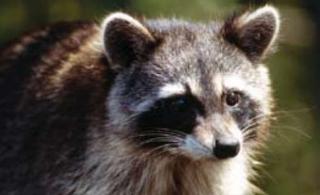 Health Risks to Humans from Raccoons
Health Risks to Humans from Raccoons
Raccoons inside or around a building can be hazardous to humans or pets in several ways that we summarize here:
- Contact with raccoon feces (or less likely, raccoon urine) can lead to Leptospirosis, a bacterial infection in humans, roundworm infections, or (less common), Visceral Larval Migrans, an infection of the central nervous system, or Giardiasis, in essence an infection of the digestive system.
- Contact with the raccoons themselves can be a risk of contracting rabies or getting bitten
- See KEEPING ANIMALS OUT of BUILDINGS
Raccoon photo: U.S. CDC, cited below.
- Anita D. Sircar, MD et. als, SUMMARIES, Case. Raccoon Roundworm Infection Associated with Central Nervous System Disease and Ocular Disease—Six States, 2013–2015 [PDF] Community Needs Assessment After Microcystin Toxin Contamination of a Municipal Water Supply—Lucas County, Ohio, September 2014: 930.
Abstract Excerpt: Baylisascaris procyonis, predominantly found in raccoons, is a ubiquitous roundworm found throughout North America. Although raccoons are typically asymptomatic when infected with the parasite, the larval form of Baylisascaris procyonis can result in fatal human disease or severe neurologic outcomes if not treated rapidly. - INFECTIOUS DISEASES of RACCOONS [PDF], Rhode Island Department of Engineering Management, retrieved 2018/06/15, original source: http://www.dem.ri.gov/programs/bnatres/agricult/pdf/raccoons.pdf
- RACCOON LATRINES: IDENTIFICATION & CLEANUP [PDF] U.S. CDC., retrieved 2018/06/15, original source: https://www.cdc.gov/parasites/baylisascaris/resources/raccoonlatrines.pdf
Excerpt:
If you have found a raccoon latrine in or near your home, cleaning the area may prevent possible infection. Eggs in newly deposited feces are not infectious and take at least 2–4 weeks to become infective. Prompt removal and destruction of raccoon feces will reduce risk for exposure and possible infection.
- RACCOONS & POOLS, U.S. CDC, retrieved 2018/06/15, original source: https://www.cdc.gov/healthywater/swimming/residential/animals/raccoons-and-pools.html
Abstract:
Raccoons can be pests and can spread germs to humans.
It is important to keep raccoons out of your pool and watch for raccoon feces (poop) in and around your pool. Raccoon feces can sometimes contain the eggs of a worm called Baylisascaris procyonis, which can infect humans, particularly children, and cause severe neurologic illness.
Baylisascaris is a roundworm parasite that commonly infects raccoons.
Raccoons infected with Baylisascaris can be found in all parts of the United States 1–13. When people are exposed to Baylisascaris eggs they can become ill.
Raccoons usually choose certain locations to defecate (poop) and then use those same places repeatedly. Raccoons can also be attracted to areas where humans live and play. In pools, raccoons usually defecate in the shallow areas (for example, on the steps).
What to do if you find raccoon feces or a dead raccoon in your pool
Although chlorine in pools will kill most germs that a raccoon could carry into the water, it does not kill Baylisascaris eggs. If raccoon feces or a dead raccoon are found in the pool: Close the pool to swimmers.
Then Test the raccoon or its feces for Baylisascaris. If the feces or raccoon tests positive for Baylisascaris, clean the pool as described in the following sections.
OR
Clean the pool as described in the following sections, if you do not want to test the raccoon feces.
Clean Your Swimming Pool if it has been Contaminated with Baylisascaris
Because Baylisascaris eggs are particularly tough, adding chlorine to the water will not kill them. If a lab test has confirmed that the raccoon was infected with Baylisascaris or you don’t know if the raccoon was infected because the raccoon’s feces were not tested, there are two options for cleaning your pool.
*Remember to close the pool to swimmers until you have finished cleaning the pool.
Option 1:
Filter the pool for a minimum of 24 hours and then backwash the pool filter. Put on disposable gloves to replace the material doing the filtering (if possible). Double bag the discarded material in plastic garbage bags. Remove gloves and place them in the garbage bags. Wash your hands thoroughly with soap and water afterwards.
Option 2:
Backwash the pool filter. Drain and hose down the pool. Put on disposable gloves to replace the material doing the filtering (if possible). Double bag the discarded material in plastic garbage bags.
Remove gloves and place them in the garbage bags. Wash your hands thoroughly with soap and water afterwards Refill the pool.
Tips for keeping raccoons out of your pool
Cover the pool area that has been visited by raccoons.
Keep the fence around the pool closed.
Find out if anyone in your area is feeding raccoons, leaving pet food outside, leaving uncovered trash outside, or using trash cans that are not properly secured.
Discourage this behavior as it could be attracting animals, particularly raccoons, to your pool.
Contact Animal Control (local government office in charge of animal issues) or a pest control removal service to relocate the animal. - Bozek, Clare K., Suzanne Prange, and Stanley D. Gehrt. "The influence of anthropogenic resources on multi-scale habitat selection by raccoons." Urban Ecosystems 10, no. 4 (2007): 413-425.
Abstract:
With the continuing spread of urban areas, gaining a greater understanding of the effect of human presence on wildlife species is essential for wildlife managers.
We determined the influence of anthropogenic resources on home range size and habitat selection of raccoons (Procyon lotor) during summer (June–August) 1996–2000 for 120 raccoons at three sites exposed to varying levels of urbanization and anthropogenic resources, specifically food.
Home range estimates were larger at the rural site than the suburban and urban sites for both genders. We used compositional analysis to examine raccoon habitat selection at the second-order home range, second-order core area, and third-order home range scales.
Woodland was consistently a highly-selected habitat type for both sexes at every spatial scale. Relative to other habitat types, habitat associated with human-related food (human use areas) was selected most often at the urban site, intermediately at the suburban site, and not selected at the rural site. Spatial scale also affected habitat selection.
Human use areas were preferentially selected at the second- and third-order level at the urban site, third-order level only at the suburban site, and at neither level at the rural site.
Additionally, intersexual differences in habitat selection were reduced at the urban site, with both sexes preferentially selecting for human use areas as well as woodland habitat.
Smaller home ranges in urbanized environments are often attributed to the abundant and concentrated anthropogenic resources associated with human activity, but with little empirical support.
Our habitat selection analyses followed our predictions that raccoon foraging is strongly influenced by the artificial distribution and abundance of human-related food. Male and female raccoons in urban areas reduce their foraging patterns and focus their foraging activity on anthropogenic foods. - Childs, James E., Aaron T. Curns, Meghan E. Dey, Les A. Real, Charles E. Rupprecht, and John W. Krebs. "Rabies epizootics [Outbreaks - Ed] among raccoons vary along a North-South gradient in the Eastern United States." Vector Borne and Zoonotic Diseases 1, no. 4 (2001): 253-267.
Abstract:
The characteristics of rabies epizootics among raccoons were investigated in 11 eastern states along a North–South gradient from New York to North Carolina.
Epizootics were defined as discrete intervals of time of at least 5 months in duration, when reported cases of raccoon rabies from an individual county exceeded the median value of raccoon rabies cases reported by that county over the entire period rabies was present among raccoons in the county.
Over the ˜20-year study period, 35,000 cases of raccoon rabies were reported, and epizootics were detected from 251 (64.4%) of 390 counties.
The median annual incidence was 0.14 epizootics per year. During the first defined epizootic in a county, the median total number of raccoons reported rabid was 47, with a median monthly incidence of rabies in raccoons of 3.1. The median lag time from the first report of a rabid raccoon in a county to the beginning of the first epizootic was 4 months.
Significant differences in the annual incidence of epizootics and monthly incidence of rabid raccoons during epizootics were observed among different states.
Although human population density and per capita health spending within counties were positively associated with increasing magnitude of epizootics, a significant difference in the characteristics of rabies epizootics in northern and southern states was apparent.
We hypothesize that environmental conditions and perhaps human influence resulted in rabies epizootics in southern states that were smaller, less-frequent, and lacking in well-defined temporal structure compared with those in northern states. - Daszak, Peter, Andrew A. Cunningham, and Alex D. Hyatt. "Emerging infectious diseases of wildlife--threats to biodiversity and human health." science 287, no. 5452 (2000): 443-449.
- Gehrt, Stanley D., " Ecology and management of striped skunks, raccoons, and coyotes in urban landscapes." People and predators: From conflict to coexistence (2004): Chapter 4, p. 81.
- Guan, Y., B. J. Zheng, Y. Q. He, X. L. Liu, Z. X. Zhuang, C. L. Cheung, S. W. Luo et al. "Isolation and characterization of viruses related to the SARS coronavirus from animals in southern China." Science 302, no. 5643 (2003): 276-278.
- Guerra, Marta A., Aaron T. Curns, Charles E. Rupprecht, Cathleen A. Hanlon, John W. Krebs, and James E. Childs. "Skunk and raccoon rabies in the eastern United States: temporal and spatial analysis." Emerging Infectious Diseases 9, no. 9 (2003): 1143.
- Jenkins, Suzanne R., Brian D. Perry, and William G. Winkler. "Ecology and epidemiology of raccoon rabies." Review of Infectious Diseases 10, no. Supplement 4 (1988): S620-S625.
Abstract:
During 1982 and 1983, the Centers for Disease Control and cooperating Middle Atlantic States and local health departments collected data on 1,610 raccoons that were submitted for rabies testing and on 133 persons who received rabies postexposure prophylaxis as a result of exposure to wild animats.
Raccoons were found most commonly in yards and residential areas. Raccoons that were killed by private citizens, animal-control personnel, or dogs had the highest positivity rate (70%), and those that were trapped had the lowest (9%).
Raccoons that were found during the day or that exhibited abnormal behavior and those that had interacted with a domestic animal were more likely to be rabid. Exami nation of the data on human exposure disclosed that many exposures could have been avoided or prevented.
Almost 50% of postexposure treatments were ad ministered to persons whose actual risk of exposure was low or nonexistent. - Kazacos, Kevin R., Lawrence A. Raymond, Evelyn A. Kazacos, and William A. Vestre. "The raccoon ascarid: a probable cause of human ocular larva migrans." Ophthalmology 92, no. 12 (1985): 1735-1744.
Abstract:
The ability of raccoon roundworm larvae, Baylisascaris procyonis, to produce ocular larva migrans (OLM) was studied in various experimental animals. In addition, the clinical and pathologic lesions were compared to those in suspected cases of human ocular baylisascariasis, in patients with diffuse unilateral subacute neuroretinitis (DUSK).
Ocular larva migrans was produced in squirrel monkeys, cynomolgus monkeys, mice, hamsters, grey squirrels, and woodchucks orally infected with B. procyonis eggs.
The clinical and histologic lesions were primarily those of retinitis, retinal hemorrhages, retinal tracks, disruption, and vasculitis; pigment migration; choroiditis; vitritis; and free or encysted larvae in ocular and extraocular tissues.
The lesions of experimental OLM correlated well with those of suspected cases of human ocular baylisascariasis and DUSN. Based on these studies, B. procyonis of raccoons should be considered as a probable cause of OLM and DUSN in humans. - Mech, L. David, and Frank J. Turkowski. "Twenty-three raccoons in one winter den." Journal of Mammalogy 47, no. 3 (1966): 529-530.
- Mikaelian, Igol, Robert Higgins, Magali Lequient, Michel Major, Francis Lefebvre, and Daniel Martineau. "Leptospirosis in raccoons in Quebec: 2 case reports and seroprevalence in a recreational area." The Canadian Veterinary Journal 38, no. 7 (1997): 440.
Abstract: Raccoons may represent a source of leptospires for humans and domestic animals.
We describe a case of severe interstitial nephritis associated with the serovar bratislava of Leptospira interrogans (1st report in wildlife), and the seroprevalence to 4 leptospire serovars in a recreational area in Quebec. - Nettles, VICTOR F., JOHN H. Shaddock, R. KEITH Sikes, and Carlos R. Reyes. "Rabies in translocated raccoons." American Journal of Public Health 69, no. 6 (1979): 601-602.
- Page, L. Kristen, Chris Anchor, Ellen Luy, Sarah Kron, Grace Larson, Lauren Madsen, Kenneth Kellner, and Timothy J. Smyser. "Backyard raccoon latrines and risk for Baylisascaris procyonis transmission to humans." Emerging infectious diseases 15, no. 9 (2009): 1530.
- Page, L. Kristen, Robert K. Swihart, and Kevin R. Kazacos. "Raccoon latrine structure and its potential role in transmission of Baylisascaris procyonis to vertebrates." The American Midland Naturalist 140, no. 1 (1998): 180-185.
- Ridenour, Jonathan. "Characteristics Of Rest Sites Used By Raccoons (procyon Lotor) In Richmond, Kentucky." (2011).
Abstract:
The raccoon (Procyon lotor) is one of many species that have adapted to living in urban/suburban environments. In this study, radio-tagged raccoons within the city limits of Richmond, KY, were monitored to locate rest sites.
A rest site is defined as any site occupied by a raccoon during the non-motile periods of its daily activity cycle. Thirty-three different rest sites were located throughout the spring and summer seasons of 2009-10.
With some rest sites being used multiple times for a total of 50. Of the individual rest sites located, 9, 16, and 8 were located in trees, in shrubs or in the ground, and in buildings, respectively, with no use of tree cavities. The most commonly used tree was black cherry (Prunus serotina).
Raccoons significantly chose the largest trees available (mean DBH 44.1 cm, t = 3.44, P < 0.05). Most ground rest sites were associated with abandoned groundhog (Marmota monax) burrows and located in vegetated edges and nearby fields.
The demands of maintaining a proper thermal neutral zone during the heat of the summer probably accounts for the frequent use of abandoned groundhog burrows as rest sites in this study. Anthropogenic sources were capitalized on by raccoons for use as rest sites in this study, e.g., chimneys, rafters of a warehouse, under a house and in a makeshift tent.
Although specific features characterizing the attractiveness of these structures as rest sites were not evident, but it was theorized that predator avoidance and cover played a significant role.
As a non-consumptive approach to raccoon population control in an urban area, I recommend a raccoon management plan implementing one or more of the following: removal of large DBH trees, trapping of groundhogs to eliminate ground rest site options, eliminating points of access into buildings, and increased maintenance (mowing) of overgrown areas. - Roussere, Gabriel P. et als, Raccoon Roundworm Eggs near Homes and Risk for Larva Migrans Disease, California Communities [PDF] U.S. CDC., retrieved 2018/06/15, original source: https://wwwnc.cdc.gov/eid/article/9/12/03-0039_article
Abstract:
The raccoon roundworm, Baylisascaris procyonis, is increasingly recognized as a cause of serious or fatal larva migrans disease in humans and animals. We assessed the potential for infection in three northern California communities by determining the density and distribution of raccoon latrines, where transmission primarily occurs, and the prevalence of eggs at private residences.
We collected fecal samples from 215 latrines and found that 44%-53% of the latrines contained B. procyonis eggs and that 16% to 32% contained infective eggs. Among the properties surveyed, 28%-49% harbored at least one latrine that was positive for B. procyonis eggs. The latrine densities in these communities were higher than any previously reported.
The presence of B. procyonis eggs in raccoon latrines was common, widespread, and closely associated with human habitation. Where raccoon densities are high, education of the public and removal of raccoons may be necessary. - Rupprecht, C. E., and J. S. Smith. "Raccoon rabies: the re-emergence of an epizootic in a densely populated area." In Seminars in virology, vol. 5, no. 2, pp. 155-164. Academic Press, 1994.
Abstract:
Investigation of sporadic or isolated cases of rabies was encouraged in the 1950s by the implementation of a national surveillance system for reporting of rabies cases.
Low level enzootic disease was recognized in several wild species during this period, including a small focus of rabies in raccoons in Florida.
Phylogenetic analysis of the virus transmitted by rabid raccoons and reconstruction of the early history of raccoon rabies in the United States suggests that rabies was present in these animals long before its recognition by the public health community and that the emergence of raccoon rabies as a major threat to public health was the result of several natural and human-mediated events.
In recent years, reports of raccoon-human contact and rabies in raccoons have increased as changes in human demographics and land development have concentrated raccoon populations in urban and suburban settings.
In addition to the natural spread of rabies from Florida to raccoon populations in Georgia, Alabama, South Carolina and North Carolina, a separate focus in the northeastern states is believed to have been caused by the translocation of raccoons from the southeast to Virginia and West Virginia.
Oral vaccination of wild species may be an important adjunct to traditional rabies control measures in the management of this disease in the future. - Strausbaugh, Larry J., William J. Murray, and Kevin R. Kazacos. "Raccoon roundworm encephalitis." Clinical Infectious Diseases 39, no. 10 (2004): 1484-1492.
- Tibbs, Meghan L., Roberta K. Newbury, and Thomas A. Nelson. "Den Site Selection by Raccoons in an Agricultural Landscape."
Abstract:
Raccoon (Procyon lotor) populations have increased dramatically throughout Illinois during the past 25 years causing concerns because they can be important nest predators and reservoirs for zoonotic diseases.
We studied seasonal use of den sites by raccoons at Prairie Ridge State Natural Area in Jasper Co. IL. Our goals were to characterize den types and whether den use differed between sexes or age-classes, assess seasonal patterns of den use, and investigate whether raccoons shift dens to be near seasonal food patches.
Twenty-four raccoons were radiocollared and tracked to 245 individual dens during January 2004-August 2005. Of these dens, 50% were in buildings, 27% in burrows, and 17% in tree cavities.
Adults and juvenile females preferred buildings, particularly in winter; whereas, juvenile males preferred burrows and brush piles, particularly in summer.
We found no evidence that raccoons shifted den sites in fall or winter to be near cornfields. However, dens were closer to wetlands in summer than in winter.
Raccoons of both sexes used barns and sheds frequently in winter. Trapping at buildings could be an efficient method of controlling raccoon populations.
...
Reader Comments, Questions & Answers About The Article Above
Below you will find questions and answers previously posted on this page at its page bottom reader comment box.
Reader Q&A - also see RECOMMENDED ARTICLES & FAQs
Question: I have had 4 sets of raccoons in my attic and chimney
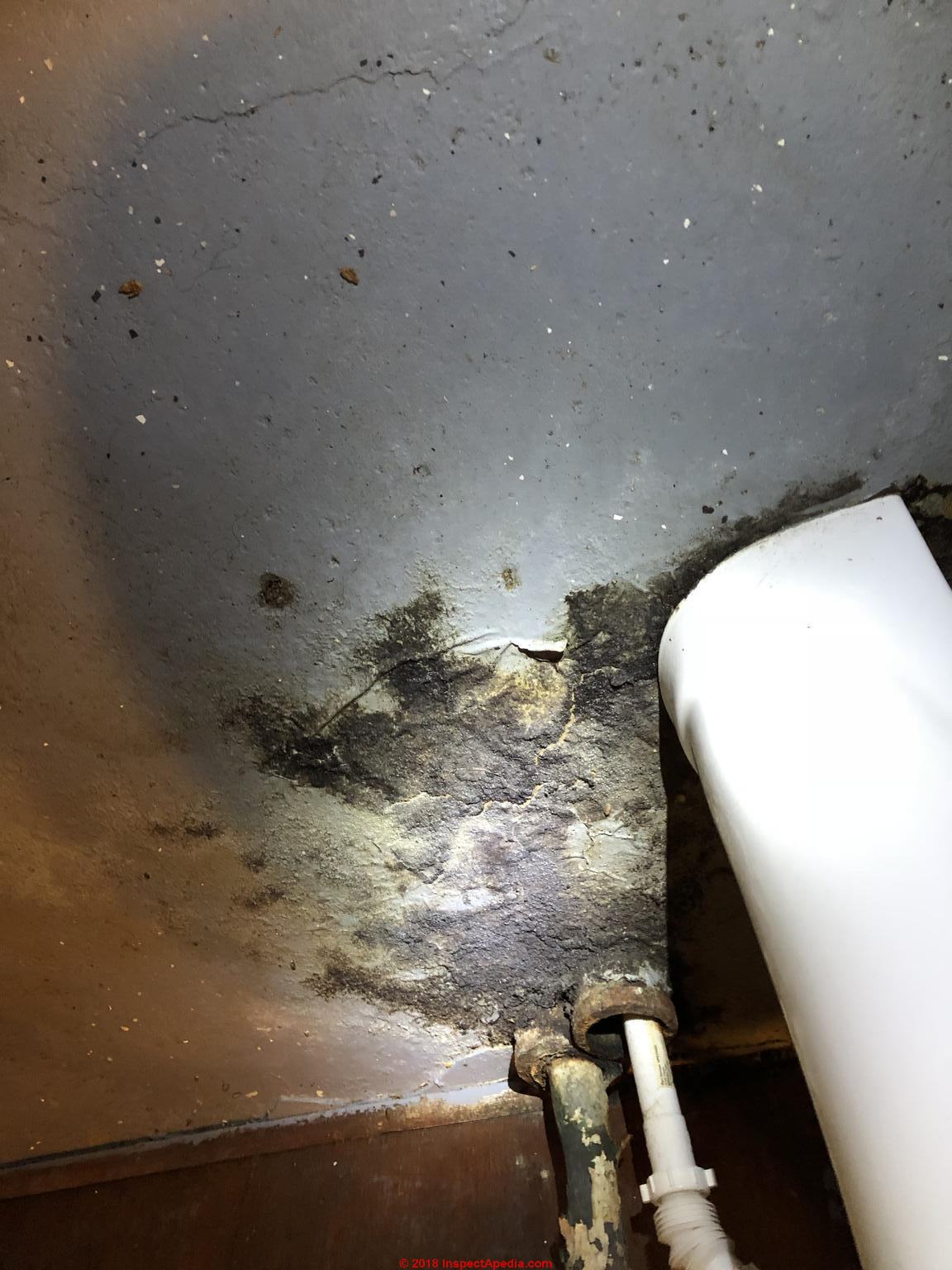 I have lived here for 3 years I rent my daughter and I are very sick the black mold is visible and it’s a known fact that a sewage cap is missing in the basement the house is always moist the whole house especially the basement and it smells like mildew it also stays cold during the cold months
I have lived here for 3 years I rent my daughter and I are very sick the black mold is visible and it’s a known fact that a sewage cap is missing in the basement the house is always moist the whole house especially the basement and it smells like mildew it also stays cold during the cold months
I have had 4 sets of raccoons in my attic and chimney also I have attached one of the photos of what I’ve found there’s way more . - 2018/06/15 Arica
Moderator Reply:
Arica,
Your photo indeed looks like mold, though a rather small area, perhaps a square foot or so - not enough, by itself to be likely to explain a health issue in a home.
However if the same leaks that produced the mold you see have also produced a larger, hidden mold colony, such as inside of a wall, ceiling, or floor, there could be a greater hazard. It's worth investigating.
Raccoons in the attic and chimney of a building can be hazardous in several ways:
- Contact with raccoon feces (or less likely, raccoon urine) can lead to Leptospirosis, a bacterial infection in humans, or (less common), Visceral Larval Migrans, an infection of the central nervous system, or Giardiasis, in essence an infection of the digestive system.
- Contact with the raccoons themselves can be a risk of contracting rabies or getting bitten
It is proper to expect your landlord to have a professional remove the raccoons and to repair the building to prevent their re-entry.
Additional cleanup and sanitizing or disinfection of the raccoon infested areas might be necessary.
You should also seek advice from your local health department.
This comment and reply were posted originally
at RENTERS & TENANTS ADVICE for UNSAFE or UNHEALTHY HOME inspectapedia.com/sickhouse/Rental_Unit_Mold.php
...
Question: Use of peppermint oil or ammonia to repel animal poopers and pests?
I have heard that peppermint smell repels
Yes the camera was too high to trigger a picture of the one in the trap. I was being ambitious thinking i could get a shot of it peeking out of the siding...tonight i will put the camera on video instead of stills. mice and squirrels. Is that so? - (Sept 23, 2012) Anonymous
Moderator Reply:
Good idea Anonymous. Peppermint is better than trying to scatter mothballs apart as using mothballs for animal repellent is an illegal application and can cause other building odor or health problems.
A number of animal repellent products do indeed contain peppermint oil, such as some deer and cat repellents. The mixtures for similar applications mix oils of peppermint, geranium, sage, lavender, eucalyptus, lemongrass etc.
There are other specific animal repellent sprays and products sold at home and garden suppliers, often targeted to specific animals: coyote urine, for example.
I've also tried pouring a bit of ammonia (or bleach but never BOTH at once) onto an area on a walkway or stair where a cat kept urinating.
Outdoors where our neighbour's cat had decided that our stone walkway was a nicer toilet than its own yard we had such an accumulation of cat poop that besides cleaning up that mess we needed to encourage Cheeto to find a different relief site.
After cleaning up the mess we poured household ammonia around the poop area. That worked.
...
Continue reading at ANIMAL ENTRY POINTS in BUILDINGS or select a topic from the closely-related articles below, or see the complete ARTICLE INDEX.
Or see these
Recommended Articles
- ANIMAL DAMAGE to BUILDINGS - home
- ANIMAL ENTRY POINTS in BUILDINGS - home
- ANIMAL NOISES in BUILDINGS
- ANIMAL or URINE ODOR SOURCE DETECTION
- BLACK STAINS from ANIMALS cause and cure of various types of stains caused by pets or other animals in buildings.
Suggested citation for this web page
RACCOONS in the ATTIC at InspectApedia.com - online encyclopedia of building & environmental inspection, testing, diagnosis, repair, & problem prevention advice.
Or see this
INDEX to RELATED ARTICLES: ARTICLE INDEX to ANIMAL PESTS, ALLERGENS, HAZARDS
Or use the SEARCH BOX found below to Ask a Question or Search InspectApedia
Ask a Question or Search InspectApedia
Try the search box just below, or if you prefer, post a question or comment in the Comments box below and we will respond promptly.
Search the InspectApedia website
Note: appearance of your Comment below may be delayed: if your comment contains an image, photograph, web link, or text that looks to the software as if it might be a web link, your posting will appear after it has been approved by a moderator. Apologies for the delay.
Only one image can be added per comment but you can post as many comments, and therefore images, as you like.
You will not receive a notification when a response to your question has been posted.
Please bookmark this page to make it easy for you to check back for our response.
IF above you see "Comment Form is loading comments..." then COMMENT BOX - countable.ca / bawkbox.com IS NOT WORKING.
In any case you are welcome to send an email directly to us at InspectApedia.com at editor@inspectApedia.com
We'll reply to you directly. Please help us help you by noting, in your email, the URL of the InspectApedia page where you wanted to comment.
Citations & References
In addition to any citations in the article above, a full list is available on request.
- In addition to citations & references found in this article, see the research citations given at the end of the related articles found at our suggested
CONTINUE READING or RECOMMENDED ARTICLES.
- Carson, Dunlop & Associates Ltd., 120 Carlton Street Suite 407, Toronto ON M5A 4K2. Tel: (416) 964-9415 1-800-268-7070 Email: info@carsondunlop.com. Alan Carson is a past president of ASHI, the American Society of Home Inspectors.
Thanks to Alan Carson and Bob Dunlop, for permission for InspectAPedia to use text excerpts from The HOME REFERENCE BOOK - the Encyclopedia of Homes and to use illustrations from The ILLUSTRATED HOME .
Carson Dunlop Associates provides extensive home inspection education and report writing material. In gratitude we provide links to tsome Carson Dunlop Associates products and services.



